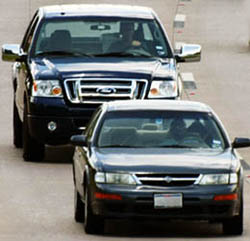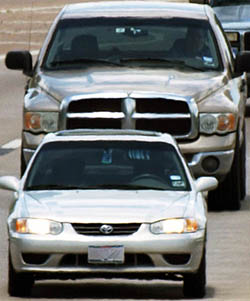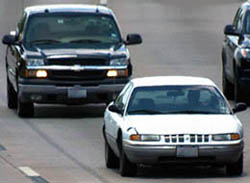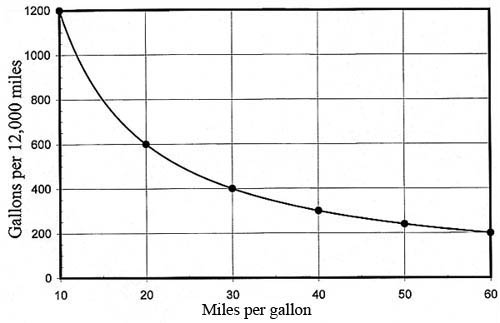Saving Gas
Today, we save gas. The University of Houston's College of Engineering presents this series about the machines that make our civilization run, and the people whose ingenuity created them.
 We've all been there: a big tailgating gas-guzzler, one car length behind us. He brakes but stays close -- angry that we aren't going five miles-an-hour faster. His car could get fourteen miles-per-gallon, but nothing wastes gas like all that braking. Smart drivers hang back and brake only when they must. Meanwhile, that fellow in our rear view mirror pays half-dollar a mile for gas.
We've all been there: a big tailgating gas-guzzler, one car length behind us. He brakes but stays close -- angry that we aren't going five miles-an-hour faster. His car could get fourteen miles-per-gallon, but nothing wastes gas like all that braking. Smart drivers hang back and brake only when they must. Meanwhile, that fellow in our rear view mirror pays half-dollar a mile for gas.
I keep close track of my own mileage. My old car isn't super economical -- 24 miles-per-gallon in the city. (I'd do much worse if I weren't careful about tail-gating and braking.)
 So should I sell my old car and replace it with an efficient hybrid? Well, simple arithmetic raises questions about doing that: Suppose that that fellow behind me drives 12,000 miles a year. And suppose he now had my car and better driving habits. He'd go from 10 miles-per-gallon to 24. That would save him almost three thousand dollars a year.
So should I sell my old car and replace it with an efficient hybrid? Well, simple arithmetic raises questions about doing that: Suppose that that fellow behind me drives 12,000 miles a year. And suppose he now had my car and better driving habits. He'd go from 10 miles-per-gallon to 24. That would save him almost three thousand dollars a year.
But if I were to buy a new hybrid, and go from 24 to 38 miles-per-gallon it'd be a different story. We'd each gain 14 miles-per-gallon. But would we each save the same amount of money? No, we wouldn't. I'd save only seven hundred dollars a year.
 If that sounds strange try this: Suppose I want to visit a friend 18 miles away: It takes me six hours on foot. Now I get a bicycle; my speed increases by 15 miles-an-hour, and I save five hours. Next, I replace my bicycle with a car and increase my speed by another 15 miles-an-hour. Now it takes me a half hour but I've saved only a half hour. The faster I'm going, the less good another 15 miles-an-hour will do. Neither miles-per-gallon, nor miles-per-hour, give proportional savings.
If that sounds strange try this: Suppose I want to visit a friend 18 miles away: It takes me six hours on foot. Now I get a bicycle; my speed increases by 15 miles-an-hour, and I save five hours. Next, I replace my bicycle with a car and increase my speed by another 15 miles-an-hour. Now it takes me a half hour but I've saved only a half hour. The faster I'm going, the less good another 15 miles-an-hour will do. Neither miles-per-gallon, nor miles-per-hour, give proportional savings.
It's a matter of diminished returns. My greatest improvement in freedom and speed of motion came when I got my first bicycle. Same with the people who drive the great gas-guzzlers: Today's skyrocketing gasoline prices leave them with the most to gain.
 But, if our car is even modestly fuel-efficient, there's far less room for improvement. We must ask if fuel savings are worth the cost of a new car, or the environmental impact of making a new car. The energy needed to make a new hybrid Prius is enough to drivethat same car 46,000 miles. And we're back to our speed analogy:
But, if our car is even modestly fuel-efficient, there's far less room for improvement. We must ask if fuel savings are worth the cost of a new car, or the environmental impact of making a new car. The energy needed to make a new hybrid Prius is enough to drivethat same car 46,000 miles. And we're back to our speed analogy:
A few years ago, we tried to introduce supersonic airplanes. I expect we really will, one day, travel at 1300 hundred miles-an-hour -- and that we'll eventually have hundred-mile-per-gallon cars.
 But those technologies are still evolving, and we still have to understand diminishing returns. Who can pay thousands of dollars to shave two hours off a flight to Paris -- or to cut gas costs by a few hundred dollars?
But those technologies are still evolving, and we still have to understand diminishing returns. Who can pay thousands of dollars to shave two hours off a flight to Paris -- or to cut gas costs by a few hundred dollars?
It's an old story: Every solution to our voracious appetites brings new problems. No magic bullet to protect us from our desires for more energy -- or our desire for speed. What we really need is some magic bullet against desire itself.
I'm John Lienhard at the University of Houston, where we're interested in the way inventive minds work.
The numbers above are based on the typical $4.00-per-gallon gasoline price, as I write in early July, 2008. I've based calculations on 12,000 miles per year, for the average driver. I've generally rounded numbers off, and my walking, biking, driving example is based on a walking speed of 3 mph. The freeway photos are just a sampling of what I found in a scant five minutes of shooting from a freeway overpass. They reflect a huge amount of braking, and a vast waste of fuel.
See, R. P. Larrick and J. B. Soll, The MPG Illusion. Science, Vol. 320, 20 June, 2008. pp. 1593-1594, to see how the measure, MPG, misleads us.
the graph below shows the nonlinear way in which our consumption of gasoline varies with fuel economy.
